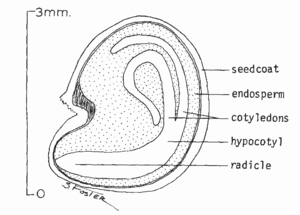Difference between revisions of "AY Honors/Seeds - Advanced/Answer Key"
(→Dicots) |
|||
| Line 27: | Line 27: | ||
*Nightshades (tomatoes, potatoes, etc) | *Nightshades (tomatoes, potatoes, etc) | ||
*Squash, pumpkin | *Squash, pumpkin | ||
| − | + | *Beans | |
<br style="clear:both"> | <br style="clear:both"> | ||
Revision as of 01:36, 9 October 2007
1. Have the Seeds Honor
2. Identify from drawings and know the purpose of each of the following parts of a seed: endosperm, radicle, plumule, micropyle.
- Endosperm
- Endosperm is the tissue produced in the seeds of most flowering plants around the time of fertilization. It surrounds the embryo and provides nutrition in the form of starch, though it can also contain oils and protein.
- Radicle
- The radicle is the first part of a seedling (a growing plant embryo) to emerge from the seed during the process of germination. The radicle is the embryonic root of the plant, and grows downward in the soil.
- Plumule
- The plumule is the embryonic shoot. It is the precursor to the stem and leaves of the plant.
- Micropyle
- The micropyle is an opening in a plant's ovule (the structure that gives rise to and contains the female reproductive cells). The micropyle opening allows the pollen tube to enter the ovule for fertilization. In gymnosperms (e.g. conifers), the pollen itself is drawn into the ovule and the micropyle opening closes after pollination. During germination, the seedling's radicle emerges through the micropyle.
3. Know several differences between a monocotyledon seed and a dicotyledon seed, and give three examples of each.
In monocotyledons (or simply monocots), the seed embryo has one cotyledon while the embryo of the dicotyledon (or dicot) has two. The major leaf veins in a monoct are parallel, but they are branched in a dicot. The flower parts (petals, sepals, etc) in monocots are multiples of three while in dicots are multiples of four or five.
Monocots
- Corn
- Grasses (such as wheat, rye, barley, etc)
- Lilies
- Onions, garlic
Dicots
- Roses
- Asters
- Nightshades (tomatoes, potatoes, etc)
- Squash, pumpkin
- Beans
4. Explain the purpose and use of a "rag doll" seed tester. Use it to test the germination of 100 seeds of a wild plant and 100 seeds of a domestic plant. Report the results of each test.
The purpose of a "rag doll" test is to determine the percentage of seeds in a given lot that will successfully germinate. This information can then used for calculating seeding rates.
A simple way to get an idea of the actual field germination prior to planting is to conduct a “ragdoll” test. A “ragdoll” consists of a rolled tube of moistened paper containing the seeds to be tested for germination, placed in plastic bag and stored in a warm place for several days. seedlings are counted as they germinate and are removed, giving the percentage of actual germination.
To conduct a ragdoll test, moisten a brown paper hand towel and squeeze out as much excess water as possible. Do not use a "soft" paper towel as are typically found in a home kitchen - seeds can send roots and tops through these complicating the count. Excess water in the towel will cut off oxygen and ruin the test.
Spread the paper towel out on a flat surface, count out 100 seeds and place them in a line (diagonally works well) across the towel. Roll the towel up and place it in a plastic bag. Seal the bag, and place it in a warm place, such as on the top of a refrigerator. A temperature of 30°C![]() is ideal.
is ideal.
After four days, remove the towel from the plastic bag, unroll it, and count and remove any seeds that have germinated. Roll the towel back up, return it to the plastic bag, reseal, and return it to the top of the refrigerator.
After three or four more days, repeat the count. The total number of seeds from both counts will equal the germination rate, assuming 100 seeds were used. If a different number of seeds were used, you can calculate the germination rate as follows:
[math]\displaystyle{ Germination\ Rate = \frac{Germinated\ Seeds}{Germinated\ Seeds + Ungerminated\ Seeds} \times 100 }[/math]
5. How does a seed differ from a spore?
6. Write or tell orally two spiritual lessons we may learn from seeds. You will find help in Christ's Object Lessons by Ellen G. White, pages 33 to 89.
7. Make a collection of 60 different kinds of seeds, of which only 15 may be collected from commercial seed packages, the other 45 you are to collect yourself. Label each kind as follows: seed name, date collected, location collected, and collector’s name.
Adventist Youth Honors Answer Book/Nature/Seeds/Seed collection



